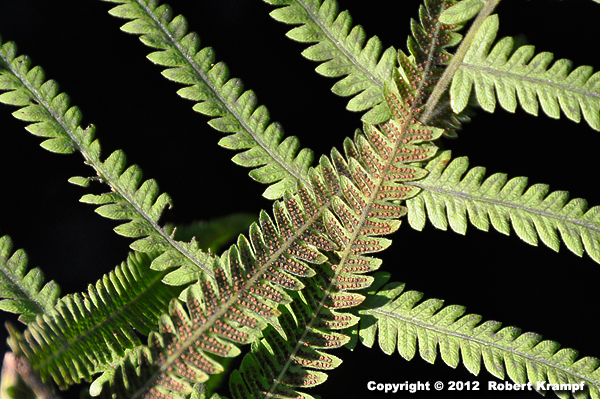
The brown spots on this fern contain spores. How are spores different from seeds?
-
Spores are much smaller, because they do not contain stored food for the young plant.
That is part of the answer. Most seeds contain stored food for the developing plant. Orchid seeds are an exception.. -
Spores are a form of asexual reproduction.
That is part of the answer. Spores contain only the genetic material from the parent plant. -
Spores develop into a different kind of plant from the parent.
This is part of the answer. Ferns have alternation of generations, which means that the spores grow into a plant called a prothallia. The prothallia produces male and female sex cells, which join, and grow into another fern plant. -
All of the above.
Yes! All three of the answers are correct.
Click to see which state standards this question tests, and which of my videos, experiments, and other resources support that topic.
Florida
SC.3.L.15.2 Classify flowering and nonflowering plants into major groups such as those that produce seeds, or those like ferns and mosses that produce spores, according to their physical characteristics.
| Pumpkin Guts | video, free, ClosedCaptions, checked |
| Seed Search | video, ClosedCaptions, checked |
| Review Plants-4 | practice |
| Review Plants-8 | practice |
SC.4.L.16.4 Compare and contrast the major stages in the life cycles of Florida plants and animals, such as those that undergo incomplete and complete metamorphosis, and flowering and nonflowering seedbearing
plants.
| Orange Slices | video, ClosedCaptions |
| Creating a Sprout Guide | text page, photography, free |
| Review Life Cycle-1 | practice |
| Review Life Cycle-2 | practice |
| Review Plants-4 | practice |
| Review Life Cycle-3 | practice |
| Review Life Cycle-4 | practice |
Utah
UT.5.V.1.e Investigate variations and similarities in plants grown from seeds of a parent plant (e.g., how seeds from the same plant species can produce different colored flowers or identical flowers).
| Review Plants-4 | practice |
UT.7.IV.1.c Cite examples of organisms that reproduce sexually (e.g., rats, mosquitoes, salmon, sunflowers) and those that reproduce asexually (e.g., hydra, planaria, bacteria, fungi, cuttings from house plants).
| Pumpkin Guts | video, free, ClosedCaptions, checked |
| Review Plants-4 | practice |
NGSS
MS-LS1-4 Use argument based on empirical evidence and scientific reasoning to support an explanation for how characteristic animal behaviors and specialized plant structures affect the probability of successful reproduction of animals and plants respectively.
| A Walk in the Park | video, checked |
| Nature Watching | video, checked |
| Calling a Woodpecker | video, checked |
| Selective Smelling | video, checked |
| Pumpkin Guts | video, free, ClosedCaptions, checked |
| Seed Search | video, ClosedCaptions, checked |
| Orange Slices | video, ClosedCaptions |
| Bacteria and Antibiotics | video, ClosedCaptions |
| Flowers | video, ClosedCaptions |
| Onion Crystals | video |
| Thoughts on an Exoskeleton | text page, free |
| How Does a Butterfly Fly? | text page, free |
| Review Adaptation-3 | practice |
| Review Plants-2 | practice |
| Review Plants-4 | practice |
| Review Adaptation-4 | practice |
| Review Adaptation-5 | practice |
| Review Adaptation-6 | practice |
| Review Plants-8 | practice |
MS-LS3-2 Develop and use a model to describe why asexual reproduction results in offspring with identical genetic information and sexual reproduction results in offspring with genetic variation.
| Extracting Your Own DNA | video |
| Review Plants-3 | practice |
| Review Plants-4 | practice |
MS-LS3-2 Develop and use a model to describe why asexual reproduction results in offspring with identical genetic information and sexual reproduction results in offspring with genetic variation.
| Extracting Your Own DNA | video |
| Review Plants-3 | practice |
| Review Plants-4 | practice |
